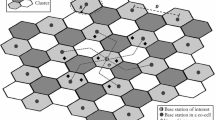Abstract
Out-of-cell interference is an important factorin determining the system capacity of CDMA systems.Out-of-cell interference is influenced by propagationparameters such as slope index s of the path loss model, the standard deviation sigma of shadowloss, and the correlation coefficients of shadow lossfor propagation from the desired base station and fromthe interfering base station. For line-of-sight (LOS) cells along streets or roadways,propagation may be described by a two-slope model thathas smaller slow-fading loss sigma and a larger slopeindex past the breakpoint Rb than thesingle-slope model. As a result, smaller out-of-cellinterference is obtained with the two-slope model,leading to system designs having less infrastructurethan are obtained using the single-slope model. In thispaper we examine how a more realistic prediction ofquality of service (QOS) made with the two-slope modelleads to cost-effective system designs.
Similar content being viewed by others
REFERENCES
K. S. Gilhousen et al., On the capacity of a cellular CDMA System, IEEE Trans. Veh. Technol., Vol. 40, No. 2, May 1991, pp. 303–312.
A. M. Viterbi and A. J. Viterbi, Erlang capacity of a power controlled CDMA system, IEEE J. Sel. Areas Comm., Vol. 11, No. 6, August 1993, pp. 892–899.
A. J. Viterbi et al., Soft handoff extends CDMA cell coverage and increases reverse link capacity, IEEE J. Sel. Areas Comm., Vol.12, No. 8, Oct. 1994, pp. 1281–1288.
M. Wallace and R. Walton, CDMA Radio Network Planning, ICUPC, San Diego, CA, Oct. 1994, pp. 62–67.
M. Chopra, K. Rohani, and J. R. Reed, Analysis of CDMA range extension due to soft handoff, 45th VTC, Chicago, IL, July 1995, pp. 917–921.
H. H. Xia, H. L. Bertoni, L. R. Maciel, A. L. Stewart, and R. Rowe, Radio propagation characteristics for LOS microcellular mobile and personal communications, IEEE Trans. Antennas and Propagations, Vol. 4, No. 10, Oct. 1993.
D. Har, H. L. Bertoni, and S. Kim, Effect of propagation modeling on LOS microcellular system design, IJWIN, Vol. 4, No. 2, 1997, pp. 113–123.
A. Mawira, Models for the spatial correlation functions of the (log)-normal component of the variability of VHF/UHF field strength in urban environment, 3rd PIMRC, Boston, MA, Oct. 1992, pp. 436–440.
M. Gudmundson, Correlation model for shadow fading in mobile radio systems, Electronic Letters, Vol. 27, No. 23, Nov. 1991.
A. J. Viterbi, CDMA Principles of Spread Spectrum Communication, Addison Wesley, 1995.
H. L. Bertoni, W. Honcharenko, L. R. Maciel, and H. H. Xia, UHF propagation prediction for wireless personal communications, Proc. IEEE, Vol. 82, 1994, pp. 1333–1359.
T. S. Rappaport, Wireless Communications: Principles and Practice, Prentice Hall, 1996.
TIA/ EIA/IS-95 Interim Standards, Mobile Station- Base Station Compatibility Standard for Dual-Mode Wideband Spread Spectrum Cellular System, Telecommunication Industry Association, July 1993.
R. Padovani, Reverse link performance of IS-95 based cellular systems, IEEE Personal Communications, 3rd quarter, 1994, pp. 28–34.
Rights and permissions
About this article
Cite this article
Min, S., Bertoni, H.L. & Kim, SC. Efficient CDMA System Design for Highway Microcells Based on Accurate Modeling of Path Loss. International Journal of Wireless Information Networks 6, 67–77 (1999). https://doi.org/10.1023/A:1018835401421
Issue Date:
DOI: https://doi.org/10.1023/A:1018835401421




